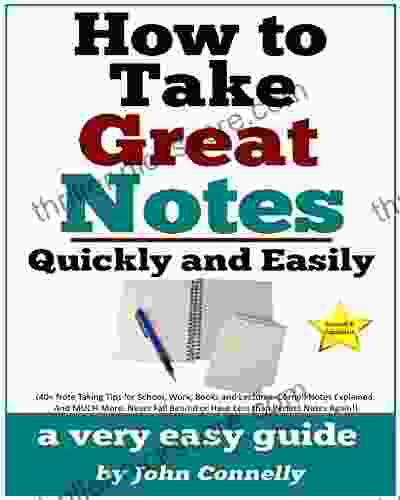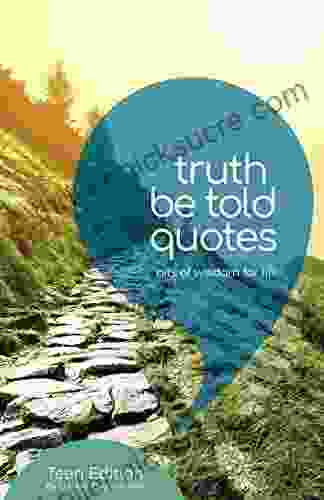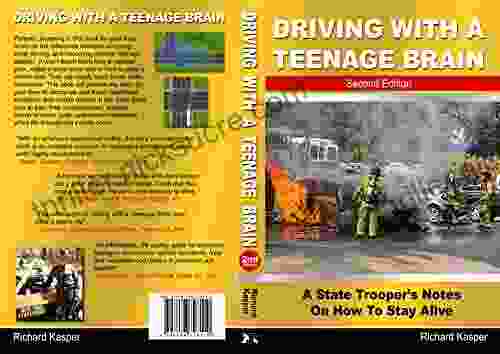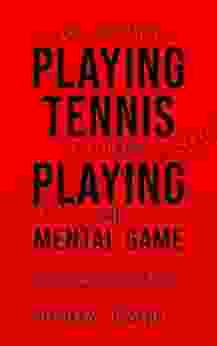40 Note Taking Tips: Master Cornell Notes for School and Lectures

Effective note-taking is a cornerstone of academic success, empowering you to retain and recall vast amounts of information. By developing efficient and strategic note-taking skills, you can maximize your learning potential, excel in your studies, and unlock the full spectrum of your cognitive abilities.
The Cornell Note-Taking Method: A Comprehensive Overview
Amongst the plethora of note-taking techniques, the Cornell Method stands out as a widely adopted and highly effective system. Created by Professor Walter Pauk at Cornell University, this technique offers a structured and visually appealing approach to organizing and absorbing information.
4.2 out of 5
| Language | : | English |
| File size | : | 3341 KB |
| Text-to-Speech | : | Enabled |
| Screen Reader | : | Supported |
| Enhanced typesetting | : | Enabled |
| Word Wise | : | Enabled |
| Print length | : | 116 pages |
| Lending | : | Enabled |
The Cornell Note-Taking Method consists of three distinct sections:
- Cue Column: Located on the left-hand margin, this column is reserved for brief keywords, questions, or prompts that will trigger your memory during review.
- Note-Taking Column: The primary section for recording lecture notes. This column should be concise, using abbreviations, symbols, and diagrams to maximize information density.
- Summary Section: Positioned at the bottom of the page, this section is used to synthesize the key points of the lecture into a concise and coherent summary.
40 Note Taking Tips for School Work and Lectures
Mastering the art of effective note-taking requires a combination of strategy, practice, and attention to detail. Embrace these 40 practical tips to elevate your note-taking skills and optimize your learning outcomes:
Pre-Lecture Preparation
- Preview the Material: Before attending a lecture, familiarize yourself with the topic by reading the assigned text or reviewing lecture notes from the previous class.
- Establish a Purpose: Determine the main goal of the lecture and identify the specific information you need to extract.
- Choose the Right Tools: Select a high-quality notebook, pens, and highlighters that are conducive to efficient note-taking.
During Lecture
- Active Listening: Engage fully with the lecture by paying attention, asking questions, and summarizing key points in your own words.
- Use the Cornell Method: Divide your page into the three sections of the Cornell Note-Taking Method to ensure clarity and organization.
- Record Essential Information: Focus on capturing the main ideas, supporting points, and any additional information that is crucial to understanding the topic.
- Use Abbreviations, Symbols, and Diagrams: Condense information by utilizing abbreviations, symbols, and diagrams to save space and facilitate quick recall.
- Color Coding: Assign different colors to different types of information, such as main points, definitions, examples, and questions.
- Leave White Space: Avoid overcrowding your notes by leaving ample white space for annotations, additions, and revisions.
- Review Regularly: Take a few minutes at the end of each lecture to review your notes, filling in any gaps and clarifying any concepts.
- Ask Questions: Do not hesitate to ask questions during the lecture if you are unclear about any aspect of the material.
Post-Lecture Review
- Summarize the Lecture: Within 24 hours of the lecture, summarize the key points and main takeaways in your own words.
- Recite and Recall: Test your understanding by covering up your notes and trying to recall the information from memory.
- Elaborate and Connect: Relate the new information to your prior knowledge and other concepts within the subject matter.
- Annotate and Revise: Add notes, corrections, and any additional information that enhances your understanding of the topic.
- Use Mind Mapping: Create a visual representation of the lecture notes using mind maps to connect ideas and identify relationships.
- Teach the Material: Explain the lecture material to a friend, family member, or study group to reinforce your understanding.
- Review Regularly: Periodically revisit your notes to refresh your memory and strengthen your long-term recall.
General Tips
- Use Technology: Consider using note-taking apps or digital notepads for enhanced organization, search functionality, and collaboration.
- Take Breaks: Regular breaks during extended note-taking sessions can improve focus and information retention.
- Maintain Consistency: Develop a consistent note-taking system that works for you and stick to it to maximize efficiency.
- Experiment with Different Methods: Explore various note-taking techniques and identify the ones that best suit your learning style.
- Seek Feedback: Ask your professors, teachers, or study group members for feedback on your note-taking skills.
- Personalize Your Notes: Make your notes visually appealing and engaging by adding colors, drawings, or other visual elements.
- Use Different Writing Instruments: Utilize pens, pencils, highlighters, and markers to differentiate between different types of information.
- Take Notes Collaboratively: Share notes with classmates or study groups to compare perspectives and fill in any gaps.
- Organize Your Notes: Categorize your notes by subject, topic, or lecture date for easy retrieval and review.
- Store Your Notes Safely: Protect your valuable notes by storing them in a secure location and making digital backups if possible.
Effective note-taking is a skill that requires dedication, practice, and a commitment to continuous improvement. By adopting the principles and techniques outlined in this comprehensive guide, you can elevate your note-taking abilities, maximize your learning potential, and achieve academic success. Embrace the power of note-taking and unlock the full potential of your mind.
4.2 out of 5
| Language | : | English |
| File size | : | 3341 KB |
| Text-to-Speech | : | Enabled |
| Screen Reader | : | Supported |
| Enhanced typesetting | : | Enabled |
| Word Wise | : | Enabled |
| Print length | : | 116 pages |
| Lending | : | Enabled |
Do you want to contribute by writing guest posts on this blog?
Please contact us and send us a resume of previous articles that you have written.
 Fiction
Fiction Non Fiction
Non Fiction Romance
Romance Mystery
Mystery Thriller
Thriller SciFi
SciFi Fantasy
Fantasy Horror
Horror Biography
Biography Selfhelp
Selfhelp Business
Business History
History Classics
Classics Poetry
Poetry Childrens
Childrens Young Adult
Young Adult Educational
Educational Cooking
Cooking Travel
Travel Lifestyle
Lifestyle Spirituality
Spirituality Health
Health Fitness
Fitness Technology
Technology Science
Science Arts
Arts Crafts
Crafts DIY
DIY Gardening
Gardening Petcare
Petcare Ned Mcintosh
Ned Mcintosh Sriman Sharma
Sriman Sharma Chukwuma Eleodimuo
Chukwuma Eleodimuo Natalia Rojas
Natalia Rojas Melinda Tankard Reist
Melinda Tankard Reist Steven Verrier
Steven Verrier Tobe Melora Correal
Tobe Melora Correal Richard Post
Richard Post Bret Stetka
Bret Stetka Lisa Druxman
Lisa Druxman Jennifer Comeaux
Jennifer Comeaux Kate Mcmillan
Kate Mcmillan John Major Jenkins
John Major Jenkins J C Cervantes
J C Cervantes Steve Wiegand
Steve Wiegand Ursula Hackett
Ursula Hackett Nibedit Dey
Nibedit Dey Susan F Paterno
Susan F Paterno George Olsen
George Olsen Richard Hingley
Richard Hingley Bruce A Fenderson
Bruce A Fenderson Dr Alison Dibarto Goggin
Dr Alison Dibarto Goggin St Teresa Of Avila
St Teresa Of Avila Clayton King
Clayton King Michael Shaw
Michael Shaw Lucas Chancel
Lucas Chancel Tyler Hamilton
Tyler Hamilton Chase Hassen
Chase Hassen Kent Hoffman
Kent Hoffman Wilborn Hampton
Wilborn Hampton Jean Nayar
Jean Nayar Jason Brick
Jason Brick Michael Barkun
Michael Barkun Marco Polo
Marco Polo David Jason
David Jason David Flanagan
David Flanagan Seb Falk
Seb Falk Joanne M Flood
Joanne M Flood Kalynn Bayron
Kalynn Bayron Lenore Skenazy
Lenore Skenazy Laura A Jana
Laura A Jana Jemar Tisby
Jemar Tisby Lindsey Schlessinger
Lindsey Schlessinger Marguerite Henry
Marguerite Henry Khalid Khashoggi
Khalid Khashoggi Mark William
Mark William Juliet Miller
Juliet Miller Dr Faith G Harper
Dr Faith G Harper Michael Ruhlman
Michael Ruhlman Michael Mason
Michael Mason Howtodressage
Howtodressage Catherine Shainberg
Catherine Shainberg Charles Wilson
Charles Wilson Dawna Markova
Dawna Markova Peter Zuckerman
Peter Zuckerman Kerry Mcdonald
Kerry Mcdonald Nicholas Bjorn
Nicholas Bjorn Htebooks
Htebooks Rory D Nelson
Rory D Nelson Avery Faigenbaum
Avery Faigenbaum J R Harris
J R Harris Brion Toss
Brion Toss John M Taylor
John M Taylor Harry Bauld
Harry Bauld Jeannie Burlowski
Jeannie Burlowski Janae M Robinson
Janae M Robinson Diana J Mason
Diana J Mason Jim White
Jim White Don L Gates
Don L Gates Dan Fullerton
Dan Fullerton Leigh Pearson
Leigh Pearson Sarah Lamb
Sarah Lamb Inger Mewburn
Inger Mewburn Stuart Woods
Stuart Woods Manfred Theisen
Manfred Theisen Roach Mary
Roach Mary Fritjof Capra
Fritjof Capra Jameswesley Rawles
Jameswesley Rawles Matt Wastradowski
Matt Wastradowski Harry Vardon
Harry Vardon Rob Collins
Rob Collins M A Hayat
M A Hayat Jonathan Grix
Jonathan Grix James M Jones
James M Jones Jhenah Telyndru
Jhenah Telyndru Elizabeth Dupart
Elizabeth Dupart Joanna Philbin
Joanna Philbin Carol Kaesuk Yoon
Carol Kaesuk Yoon Paul Weamer
Paul Weamer Cpt Exam Prep Team
Cpt Exam Prep Team Carol Newell
Carol Newell Bonnie Henderson
Bonnie Henderson 1st Ed 2018 Edition Kindle Edition
1st Ed 2018 Edition Kindle Edition Joyce Bas
Joyce Bas Scott Jurek
Scott Jurek Dan Washburn
Dan Washburn Molly Caldwell Crosby
Molly Caldwell Crosby Jeanne Ellis Ormrod
Jeanne Ellis Ormrod Michael Sullivan Iii
Michael Sullivan Iii Grace Mccready
Grace Mccready Jules Wake
Jules Wake Scott Hawthorn
Scott Hawthorn Bryan Berard
Bryan Berard Keith Ryan Cartwright
Keith Ryan Cartwright Joan Nathan
Joan Nathan John D Couch
John D Couch Cal Ripken
Cal Ripken Jp Lepeley
Jp Lepeley James A Whittaker
James A Whittaker Kelle James
Kelle James J Wayne Fears
J Wayne Fears Linda Carter
Linda Carter Genevieve Bardwell
Genevieve Bardwell Brian Gewirtz
Brian Gewirtz Terence Tao
Terence Tao Meg Cabot
Meg Cabot Richard Kasper
Richard Kasper Dusan Petkovic
Dusan Petkovic Sarah Kleck
Sarah Kleck Steven W Vannoy
Steven W Vannoy Nicholas Gallo
Nicholas Gallo Maria Sharapova
Maria Sharapova Matt Parker
Matt Parker Dr Nanhee Byrnes
Dr Nanhee Byrnes Eric C Lindstrom
Eric C Lindstrom Maggie Dallen
Maggie Dallen Rob Coppolillo
Rob Coppolillo Renee Jain
Renee Jain Dr Monique Thompson Dha Lpc
Dr Monique Thompson Dha Lpc Warren Hansen
Warren Hansen Mary Heffernan
Mary Heffernan Rich Cohen
Rich Cohen Mike Adams
Mike Adams Nora Roberts
Nora Roberts Brian Noyes
Brian Noyes Nick Heil
Nick Heil Steven Emanuel
Steven Emanuel Luis Preto
Luis Preto Della Ata Khoury
Della Ata Khoury Kathleen Bartholomew
Kathleen Bartholomew Elizabeth Davis
Elizabeth Davis J F James
J F James Karen Ward Mahar
Karen Ward Mahar Cecilia Twinch
Cecilia Twinch Guido W Imbens
Guido W Imbens Bobbi Conner
Bobbi Conner Phyllis Books
Phyllis Books Kevin Alexander
Kevin Alexander Patrick Garbin
Patrick Garbin Ian Tuhovsky
Ian Tuhovsky Cassandra Overby
Cassandra Overby Santari Green
Santari Green Jeannette De Wyze
Jeannette De Wyze John Connelly
John Connelly Kindle Edition
Kindle Edition Joanna Sayago Golub
Joanna Sayago Golub Lisa Scottoline
Lisa Scottoline Christine Brennan
Christine Brennan Steve Williams
Steve Williams Thomas Malory
Thomas Malory Hal R Varian
Hal R Varian Michel Odent
Michel Odent Phil Williams
Phil Williams Caitlin Flanagan
Caitlin Flanagan William Souder
William Souder Mike Weatherstone
Mike Weatherstone Laurie A Watkins
Laurie A Watkins Sujit Sivasundaram
Sujit Sivasundaram Pedro Sarmiento De Gamboa
Pedro Sarmiento De Gamboa Eric Michael
Eric Michael Brian Herne
Brian Herne Stephanie Sarkis
Stephanie Sarkis Scott Reed
Scott Reed Brett Hull
Brett Hull Kara Forney
Kara Forney Douglas Wood
Douglas Wood Kusha Karvandi
Kusha Karvandi David Hatcher Childress
David Hatcher Childress Samuel Greenberg
Samuel Greenberg Michael Sean Comerford
Michael Sean Comerford James Kaiser
James Kaiser Salima Ikram
Salima Ikram Hiram Bingham
Hiram Bingham Derek Blasberg
Derek Blasberg Tom M Apostol
Tom M Apostol Worth Books
Worth Books Chuanwei Li
Chuanwei Li Daniel Vaughan
Daniel Vaughan Nathan Halberstadt
Nathan Halberstadt Brienne Murk
Brienne Murk William Albert Robinson
William Albert Robinson Damien Cox
Damien Cox Megan Whalen Turner
Megan Whalen Turner Erin Mckittrick
Erin Mckittrick Vincent W Davis
Vincent W Davis Shayla Black
Shayla Black David Wootton
David Wootton Lana Peek
Lana Peek Murray Shukyn
Murray Shukyn Jackie Freeman
Jackie Freeman Brett Stewart
Brett Stewart Xavier Wells
Xavier Wells Ronald M Rapee
Ronald M Rapee D Enette Larson Meyer
D Enette Larson Meyer Jeremy Bradstreet
Jeremy Bradstreet Mary Strand
Mary Strand Curtis Wilkie
Curtis Wilkie Mark Powell
Mark Powell Colette Harris
Colette Harris Daniel Bergner
Daniel Bergner Estelle Dautry
Estelle Dautry Mark J Ferrari
Mark J Ferrari Danny Staple
Danny Staple Jane Albert
Jane Albert Julie Cangialosi
Julie Cangialosi Maurice Herzog
Maurice Herzog Brogan Steele
Brogan Steele Kazumi Tabata
Kazumi Tabata Cecelia Ahern
Cecelia Ahern James Zug
James Zug Jonathan H Turner
Jonathan H Turner Marc J Reilly
Marc J Reilly Ryan M Cleckner
Ryan M Cleckner Frederick L Coolidge
Frederick L Coolidge S Connolly
S Connolly Richard Bass
Richard Bass Matt Morton
Matt Morton Roman Gurbanov
Roman Gurbanov Oded Galor
Oded Galor Jaime Flowers
Jaime Flowers Jessica Minahan
Jessica Minahan Lee Alan Dugatkin
Lee Alan Dugatkin Peter Wacht
Peter Wacht Lewis Black
Lewis Black David Hoffman
David Hoffman Tim Falconer
Tim Falconer Mike Eastman
Mike Eastman Nehemia Gordon
Nehemia Gordon Michael Masters
Michael Masters Steve Guest
Steve Guest Peggy Kaye
Peggy Kaye Martin Sternstein
Martin Sternstein Kathleen Taylor
Kathleen Taylor Jeremy J Baumberg
Jeremy J Baumberg Patty Wipfler
Patty Wipfler Karl F Kuhn
Karl F Kuhn Sunil Tanna
Sunil Tanna Rachel Mcgrath
Rachel Mcgrath Ann Imig
Ann Imig Zigzag English
Zigzag English Kyle Rohrig
Kyle Rohrig Clyde Soles
Clyde Soles Martin Wells
Martin Wells Deepak Chopra
Deepak Chopra Loan Le
Loan Le Steve Schwartz
Steve Schwartz Cheryl Diamond
Cheryl Diamond Sandra M Nettina
Sandra M Nettina Eric R Dodge
Eric R Dodge Shannon Warden
Shannon Warden E L Konigsburg
E L Konigsburg Paula Brackston
Paula Brackston John Jeffries Martin
John Jeffries Martin Brian Reddington
Brian Reddington Alan D Moore
Alan D Moore Eze Ugbor
Eze Ugbor Daniel Bagur
Daniel Bagur Carol Walters
Carol Walters Lee Mcintyre
Lee Mcintyre Jay Asher
Jay Asher James Dean
James Dean George Case
George Case Pittacus Lore
Pittacus Lore David Murray
David Murray John Moren
John Moren Daniel Dell Uomo
Daniel Dell Uomo Neil Postman
Neil Postman Grace Friedman
Grace Friedman Roshani Chokshi
Roshani Chokshi J R Mathews
J R Mathews Jp Kriya
Jp Kriya Leslie Valiant
Leslie Valiant Brian Everitt
Brian Everitt Richard A Jaffe
Richard A Jaffe Christopher Clarey
Christopher Clarey Chuck Callaway
Chuck Callaway Patti Henry
Patti Henry John Bradshaw
John Bradshaw Varg Freeborn
Varg Freeborn Jodi Aman
Jodi Aman Sara Gaviria
Sara Gaviria Brian R King
Brian R King Dave Ramsey
Dave Ramsey Melanie Challenger
Melanie Challenger Lily Raff Mccaulou
Lily Raff Mccaulou David Hackett Fischer
David Hackett Fischer Ernle Bradford
Ernle Bradford Robert Wright
Robert Wright Sam Sorbo
Sam Sorbo Mitt Romney
Mitt Romney Mick Conefrey
Mick Conefrey David Mcclung
David Mcclung Scott Haines
Scott Haines Lori Lyons
Lori Lyons Bruce Lee
Bruce Lee Dave Cutcher
Dave Cutcher John Mclachlan
John Mclachlan Mark Lazerus
Mark Lazerus Carol Dawson
Carol Dawson Natalia Ilyin
Natalia Ilyin Milne Cc Pocock
Milne Cc Pocock Nancy Boyd Franklin
Nancy Boyd Franklin Debra Fine
Debra Fine Miguel Crespo
Miguel Crespo Richard Blais
Richard Blais Denise Long
Denise Long Colleen Doyle Bryant
Colleen Doyle Bryant Soong Chan Rah
Soong Chan Rah Krishna Godhania
Krishna Godhania Rich Osthoff
Rich Osthoff Jonti Marks
Jonti Marks Dava Sobel
Dava Sobel Gustav Meyrink
Gustav Meyrink Dinesh Kumar Goyal
Dinesh Kumar Goyal Trish Kuffner
Trish Kuffner Lukas M Verburgt
Lukas M Verburgt Nicole Morales Lm Cpm
Nicole Morales Lm Cpm Jason Sandy
Jason Sandy Caitlyn Dare
Caitlyn Dare Ksenia K
Ksenia K Brooks Blevins
Brooks Blevins Martin A Lee
Martin A Lee Steven Shapin
Steven Shapin Jacob Boehme
Jacob Boehme Wil Fleming
Wil Fleming Adrienne Onofri
Adrienne Onofri Breanna Hayse
Breanna Hayse Genie Reads
Genie Reads Patrick Carnes
Patrick Carnes Sue Wieger
Sue Wieger David Sinclair
David Sinclair James Miller
James Miller Luis Angel Echeverria
Luis Angel Echeverria John Cooper
John Cooper Joseph Ewing
Joseph Ewing Jacqueline Houtman
Jacqueline Houtman Brett Cohen
Brett Cohen Nadim Saad
Nadim Saad Emil Frlez
Emil Frlez James D Tabor
James D Tabor Brian W Kernighan
Brian W Kernighan Rick Steves
Rick Steves Jez Cajiao
Jez Cajiao Paul Simpson
Paul Simpson Samuel Arbesman
Samuel Arbesman Robert Ullman
Robert Ullman Gerald R Allen
Gerald R Allen Martin Odersky
Martin Odersky Lucy Hopping
Lucy Hopping Joanna Faber
Joanna Faber Malcolm Hebron
Malcolm Hebron Gjoko Muratovski
Gjoko Muratovski Smart Edition
Smart Edition Lisa Leake
Lisa Leake David Barrie
David Barrie Stephen Hawking
Stephen Hawking Colleen Craig
Colleen Craig Henry Worsley
Henry Worsley Einat L K
Einat L K William Shakespeare
William Shakespeare Christopher Ketcham
Christopher Ketcham Grete Waitz
Grete Waitz Samantha Michaels
Samantha Michaels Garrett Redfield
Garrett Redfield Brittany Cavallaro
Brittany Cavallaro Colleen Houck
Colleen Houck John Fraser Hart
John Fraser Hart Grace Mariana Rector
Grace Mariana Rector David Cannon
David Cannon T J Tomasi
T J Tomasi Kaylene Yoder
Kaylene Yoder Steven Hugg
Steven Hugg Ivan Savov
Ivan Savov Frederick Grinnell
Frederick Grinnell Kathleen Cushman
Kathleen Cushman Jeanne Flavin
Jeanne Flavin Jay H Lefkowitch
Jay H Lefkowitch Thomas A Jacobs
Thomas A Jacobs Michael Omi
Michael Omi Neil S Jacobson
Neil S Jacobson Sean Michael Wilson
Sean Michael Wilson Elliot Davis
Elliot Davis Matt Schifferle
Matt Schifferle Calvin Trillin
Calvin Trillin Sandy Jones
Sandy Jones T D Wilson
T D Wilson Karen E Mcconnell
Karen E Mcconnell Inge Bell
Inge Bell Alex Horne
Alex Horne Lucinda Scala Quinn
Lucinda Scala Quinn Steven Cross
Steven Cross Steve Bromley
Steve Bromley Dan Jones
Dan Jones David Barrett
David Barrett Ji Kim
Ji Kim Charlie Francis
Charlie Francis Peggy Tharpe
Peggy Tharpe Geoffrey Simpson
Geoffrey Simpson Celina Grace
Celina Grace Ethan Bezos
Ethan Bezos Doug Peacock
Doug Peacock Paul Farmer
Paul Farmer Elsevier
Elsevier Joe Grant
Joe Grant Nachole Johnson
Nachole Johnson Victor A Bloomfield
Victor A Bloomfield Peter Allison
Peter Allison Judith A Owens
Judith A Owens John Mcenroe
John Mcenroe Ron Lieber
Ron Lieber Emily Lauren Dick
Emily Lauren Dick Keith Ammann
Keith Ammann David M Ewalt
David M Ewalt Joseph Burbridge
Joseph Burbridge John Wesson
John Wesson Robin Dunbar
Robin Dunbar Jimmie Holland
Jimmie Holland Keith Foskett
Keith Foskett Thao Te
Thao Te Lucia Guglielminetti
Lucia Guglielminetti Mariana Monteiro
Mariana Monteiro Adam Night
Adam Night Gerald L Schroeder
Gerald L Schroeder D Levesque
D Levesque Esther Hicks
Esther Hicks Paul Carus
Paul Carus D S Malik
D S Malik Florence Weiser
Florence Weiser Diane Ravitch
Diane Ravitch P A Johnson
P A Johnson Bruce Macdonald
Bruce Macdonald Tim Dunn
Tim Dunn Patricia Wooster
Patricia Wooster Ilchi Lee
Ilchi Lee Kicki Hansard
Kicki Hansard Steve Oakes
Steve Oakes Kira Breed Wrisley
Kira Breed Wrisley Eduardo Montano
Eduardo Montano Melissa Trevathan
Melissa Trevathan Megan Kelley Hall
Megan Kelley Hall Toni Weschler
Toni Weschler Edith Hall
Edith Hall Joyce Harper
Joyce Harper Kate S Martin
Kate S Martin Claudia M Gold
Claudia M Gold Brian Kilmeade
Brian Kilmeade Courtney Macavinta
Courtney Macavinta Heyward Coleman
Heyward Coleman John A Fortunato
John A Fortunato Scott Zimmerman
Scott Zimmerman Nate Allen
Nate Allen Phillip Stephen Schulz
Phillip Stephen Schulz Jackson T Markbrown
Jackson T Markbrown O S Hawkins
O S Hawkins David Schoem
David Schoem Tadashi Yoshimura
Tadashi Yoshimura Masaaki Kijima
Masaaki Kijima Derick Lugo
Derick Lugo Karen Wilkinson
Karen Wilkinson Steven Trustrum
Steven Trustrum Cindy Margolis
Cindy Margolis Piero Ferrucci
Piero Ferrucci Harold Gatty
Harold Gatty Larry A Yff
Larry A Yff Charles Todd
Charles Todd F R Lifestyle
F R Lifestyle Cal Pater
Cal Pater Nicholas S Howe
Nicholas S Howe Sonja Schwartzbach
Sonja Schwartzbach James O Prochaska
James O Prochaska Helen Zee
Helen Zee Michael A Tompkins
Michael A Tompkins Elwyn Hartley Edwards
Elwyn Hartley Edwards Rick J Scavetta
Rick J Scavetta Jennifer Block
Jennifer Block Dr Lena Edwards
Dr Lena Edwards Mark Seemann
Mark Seemann Matt Doeden
Matt Doeden Matt Davids
Matt Davids Claudia Gray
Claudia Gray Joel Ingersoll
Joel Ingersoll Emilee Day
Emilee Day Mahmood Mamdani
Mahmood Mamdani Gene Kritsky
Gene Kritsky Douglas R Hofstadter
Douglas R Hofstadter Mark Johnston
Mark Johnston Sara Elliott Price
Sara Elliott Price Heather Rose
Heather Rose Porter Shimer
Porter Shimer Kenneth Paul Rosenberg
Kenneth Paul Rosenberg Penny Alexander
Penny Alexander Mohammad F Anwar
Mohammad F Anwar Deborah Shouse
Deborah Shouse Bernard Darwin
Bernard Darwin Collins O Onwe
Collins O Onwe Mark Howard
Mark Howard Stephen Wood
Stephen Wood Kevin Marx
Kevin Marx John Monaghan
John Monaghan Vicki Franz
Vicki Franz David Levithan
David Levithan Tom Cunliffe
Tom Cunliffe Guy P Harrison
Guy P Harrison Arthur Scott Bailey
Arthur Scott Bailey Michael O Emerson
Michael O Emerson Pastor Ahyh
Pastor Ahyh Gabriel F Federico
Gabriel F Federico Gerson S Sher
Gerson S Sher Mitchel P Roth
Mitchel P Roth Janice L Raymond
Janice L Raymond Stephanie Perkins
Stephanie Perkins Christy Teglo
Christy Teglo Don Brown
Don Brown Carlo Zen
Carlo Zen Iwan Rhys Morus
Iwan Rhys Morus Jacques Vallee
Jacques Vallee Pat Manocchia
Pat Manocchia E G Richards
E G Richards F Brent Neal
F Brent Neal Rob Vollman
Rob Vollman Megan Davidson
Megan Davidson James Floyd Kelly
James Floyd Kelly William Trubridge
William Trubridge Matthew Desmond
Matthew Desmond G E R Lloyd
G E R Lloyd Rosalyn Sheehy
Rosalyn Sheehy Mary Morrison
Mary Morrison Rahul Jandial
Rahul Jandial Judy H Wright
Judy H Wright Jd Tanner
Jd Tanner Ted Franklin Belue
Ted Franklin Belue Rachel Love Nuwer
Rachel Love Nuwer Timothy A Sisemore
Timothy A Sisemore Loyd Ellis
Loyd Ellis Marc Bona
Marc Bona Megan Smolenyak
Megan Smolenyak Paula Span
Paula Span
Light bulbAdvertise smarter! Our strategic ad space ensures maximum exposure. Reserve your spot today!
 Xavier BellFollow ·11.7k
Xavier BellFollow ·11.7k Anton ChekhovFollow ·3.5k
Anton ChekhovFollow ·3.5k Griffin MitchellFollow ·4.1k
Griffin MitchellFollow ·4.1k Austin FordFollow ·15.7k
Austin FordFollow ·15.7k Marcel ProustFollow ·10.7k
Marcel ProustFollow ·10.7k Jacob HayesFollow ·9.8k
Jacob HayesFollow ·9.8k Guillermo BlairFollow ·2.2k
Guillermo BlairFollow ·2.2k Isaac AsimovFollow ·18.1k
Isaac AsimovFollow ·18.1k

 Guillermo Blair
Guillermo Blair2nd Edition Revised And Expanded 2024: A Comprehensive...
The 2nd Edition Revised...

 Ronald Simmons
Ronald SimmonsDreaming of Ocean Cruising: A Voyage into Tranquility and...
For those seeking a respite from the mundane...
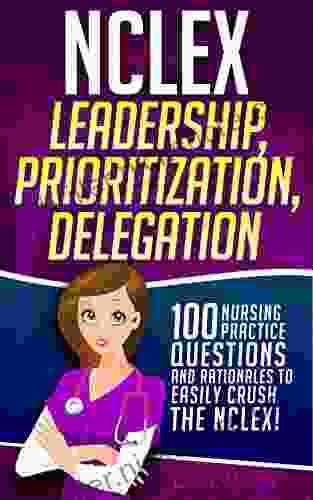
 Darren Nelson
Darren Nelson100 Nursing Practice Questions with Rationales to...
The NCLEX exam is a challenging but...

 Rex Hayes
Rex HayesMastering Bodyweight Training for Martial Arts: A...
For martial...
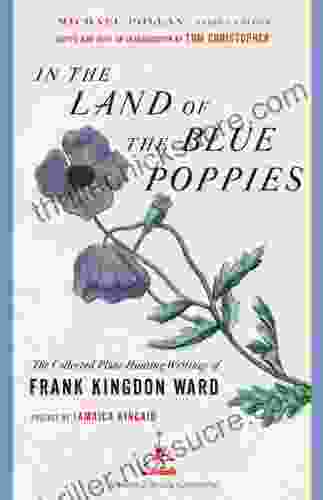
 Dillon Hayes
Dillon HayesIn The Land Of The Blue Poppies: A Literary Journey to...
Prologue: A Tapestry of...
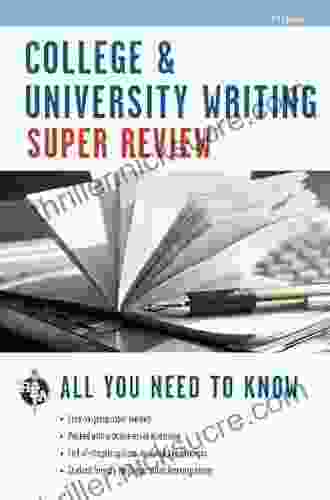
 Eliot Foster
Eliot FosterCollege University Writing Super Review Flash Card Books:...
College University...
4.2 out of 5
| Language | : | English |
| File size | : | 3341 KB |
| Text-to-Speech | : | Enabled |
| Screen Reader | : | Supported |
| Enhanced typesetting | : | Enabled |
| Word Wise | : | Enabled |
| Print length | : | 116 pages |
| Lending | : | Enabled |


